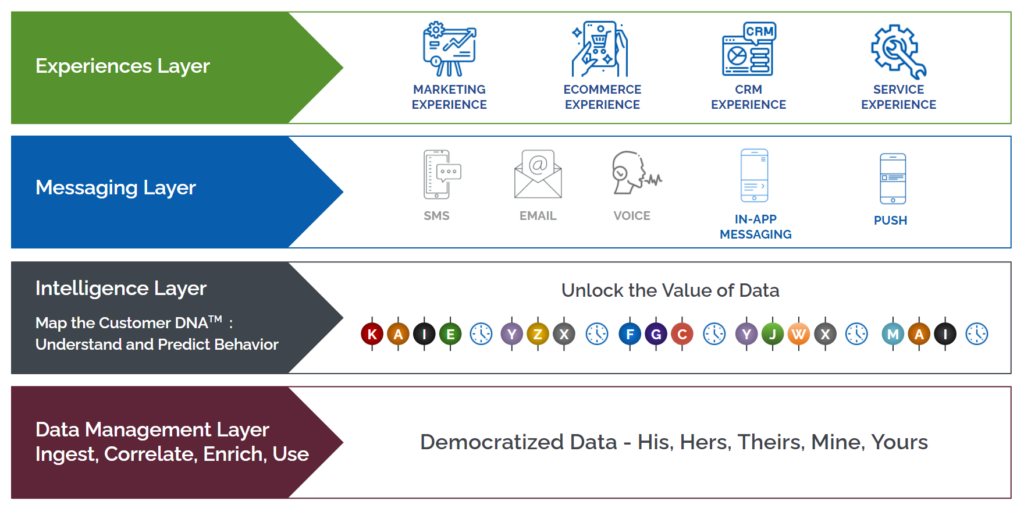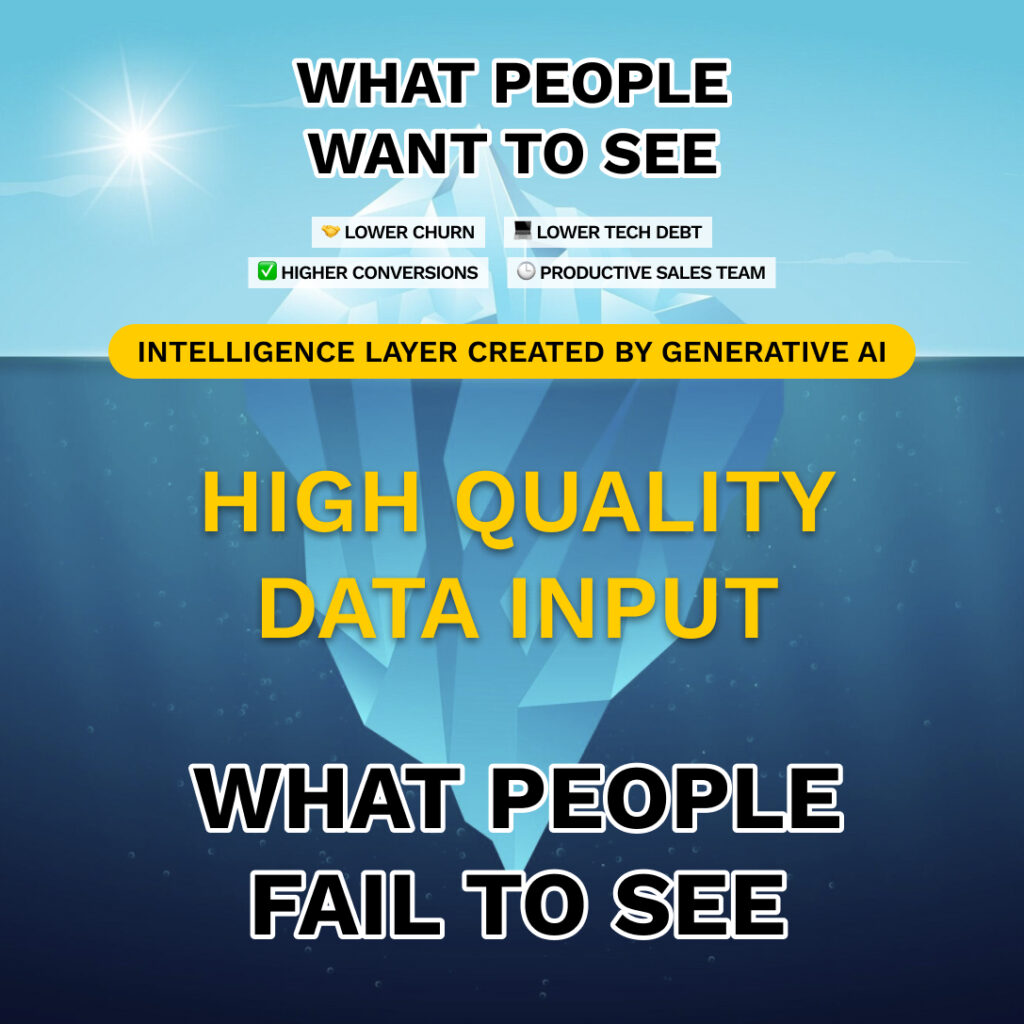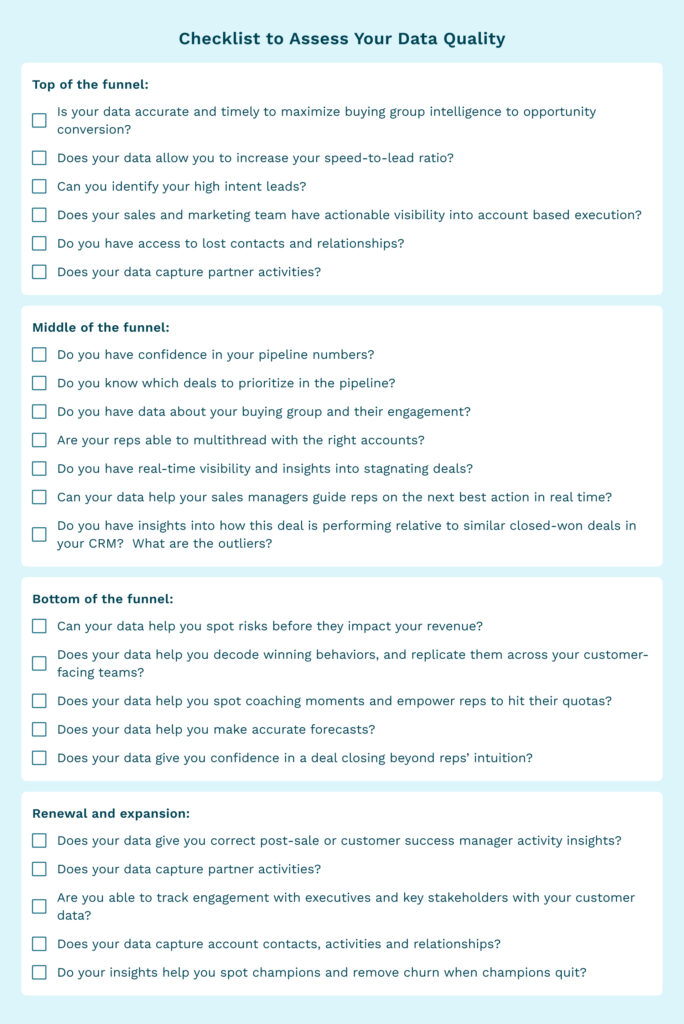2023 saw the rise of more tools and consolidation in the sales tech market.
With this, there has been some debate about what the future might look like.
Will companies continue to invest in point solutions?
Or will the customers prefer an “all in one” tool that takes care of most of their needs?
Well, only time will reveal what the landscape will look like.
But what is clear is customers prefer technology that helps them close more revenue, and address gaps that exist throughout the customer lifecycle.
The entire customer journey, from lead to opportunity to revenue is riddled with complexities.
Tools that help drive a unified visibility across the funnel and align teams with clean and complete data will be successful in coming times.
And an intelligence layer is what can take companies closer to their revenue targets.
What is an Intelligence Layer?
An intelligence layer is the key that unlocks the data and exposes patterns that have long been trapped in databases and applications.
This layer knows how to make use of data that is continuously streaming into systems and has the ability to provide insights at the time of need. This layer also is intelligent enough to know that it needs to continuously evolve and adapt to keep itself updated.
In that way, it has the ability to marry historical context with the continuous oncoming of data about accounts, opportunities and prospects. And offers predictive signals into what can add value to the buying journey at any given point in time.

These signals can open up the possibilities of real-time predictive engagement. This makes it proactive, rather than reactive.
It is the battle for this system of action that will win the sales tech game.
Revenue leaders are asking – “Which solution can deliver the best insights in a single User Interface that serves as a rep’s point of decision and point of action?”
Whether it’s deciding who to reach out to, which deal to go after this week, or which deal to revive, an intelligence layer shares a predictive list of actions that pushes your teams towards deal closure.
These insights are highly valuable as it produces signals to ensure customer-facing teams are always focused on the highest-value and most-likely-to-convert accounts at all times.
The Real Story: It’s Not Just About the Algorithms
While this intelligence layer will definitely be the winner in coming times, the usefulness of it will depend on the data underneath it.
Because AI requires meaningful data to recommend improvements that help improve revenue outcomes.
In short, building an intelligence layer requires business to have a solid data layer underneath it.
Otherwise even the best of breed cannot undo the effects that bad data has on revenue.

Unfortunately, most businesses are still struggling with data quality.
A recent survey by Modern Sales Pros along with Buzzboard revealed the following:
- Only 6% of respondents reported being highly confident of their data.
- 58% of respondents reported data accuracy as the number one reason impacting their ability to collect quality data.
- 37% said poor quality data leads to poor conversion rates.
Clearly, data quality is a challenge for organizations currently.
The questions revenue leaders must ask are:
- What will be my data source when I deploy generative AI apps?
- Do I trust the quality of my data?
- Is my data clean and accurate to drive reliable insights for my business?
For a business that is unsure of the quality of data it has in its systems, adding even the most advanced generative AI solution to their tech stack won’t improve their revenue outcomes.
It will add more tech debt to their business.
Such data inefficiencies prevent an intelligence layer from delivering its true potential.
Bad Quality Data Leads to Poor Conversions
Incomplete and inaccurate contact data has a direct impact on conversion rates, and hence revenue.
In a survey, 37% of revenue professionals said poor data fuels poor conversion rates.
Without the right data and insights at their disposal, demand generation and sales teams are unable to:
- Get the right leads into their sales funnel.
- Nurture those leads down the funnel.
- Identify the most viable prospects to engage with.
- Run highly personalized campaigns and outreach
This is where the intelligence layer (AI) has to converge with data to help organizations meet their current gaps in revenue generation.
Accurate, rich and complete account data is foundational to build an AI driven sales organization.
And those who don’t invest in a strong foundation may not be able to withstand the rapid pace and changes in today’s sales environment.
Characteristics of Good Quality Data
The quality of your data rests on a number of characteristics that it must meet. Data quality is considered superior when it is:
- Accurate
- Automated
- Complete
- Timely
All of these characteristics come together to determine data quality – the basis for making good decisions.
A quality dataset is crucial to support successful AI, as models are only as good as the data you put in them. This idea of data quality is an important part of having a solution that delivers consistent results.
Checklist to Assess Your Data Quality
If you think you have good quality data in your systems, ask again.
Here is a checklist of questions we have that can help you assess your current data quality status.
Top of the funnel:
- Is your data accurate and timely to maximize buying group intelligence to opportunity conversion?
- Does your data allow you to increase your speed-to-lead ratio?
- Can you identify your high intent leads?
- Does your sales and marketing team have actionable visibility into account based execution?
- Do you have access to lost contacts and relationships?
- Does your data capture partner activities?
Middle of the funnel:
- Do you have confidence in your pipeline numbers?
- Do you know which deals to prioritize in the pipeline?
- Do you have data about your buying group and their engagement?
- Are your reps able to multithread with the right accounts?
- Do you have real-time visibility and insights into stagnating deals?
- Can your data help your sales managers guide reps on the next best action in real time?
- Do you have insights into how this deal is performing relative to similar closed-won deals in your CRM? What are the outliers?
Bottom of the funnel:
- Can your data help you spot risks before they impact your revenue?
- Does your data help you decode winning behaviors, and replicate them across your customer-facing teams?
- Does your data help you spot coaching moments and empower reps to hit their quotas?
- Does your data help you make accurate forecasts?
- Does your data give you confidence in a deal closing beyond reps’ intuition?
Renewal and expansion:
- Does your data give you correct post-sale or customer success manager activity insights?
- Does your data capture partner activities?
- Are you able to track engagement with executives and key stakeholders with your customer data?
- Does your data capture account contacts, activities and relationships?
- Do your insights help you spot champions and remove churn when champions quit?
If your answer is no to any of the above data questions, you have to check the status of your data hygiene.
Here’s a downloadable image for you to save this checklist.

With the right data strategy, you can find a way to fill these gaps.
We continuously interview experts on how to create this strong data culture. Here are some of our top reads:
Expert Tips on How to Conquer Bad Data
How to Turn your Data into Actionable Insights
How to Orchestrate Siloed Data in your Business
How to Transform Data Hygiene with RevOps
Data Lies at the Heart of the Intelligence Layer
While generative AI is only going to increase its offerings, it’s critical to not ignore the data quality aspect that charges the intelligence layer.
It’s not just about having a lot of data to feed the systems, but ensuring trustworthy and reliable data underneath it to actually deliver what it promises.
Make data quality your priority by building an iron-clad data foundation.
For a free consultation on your current data health, get in touch with us.









